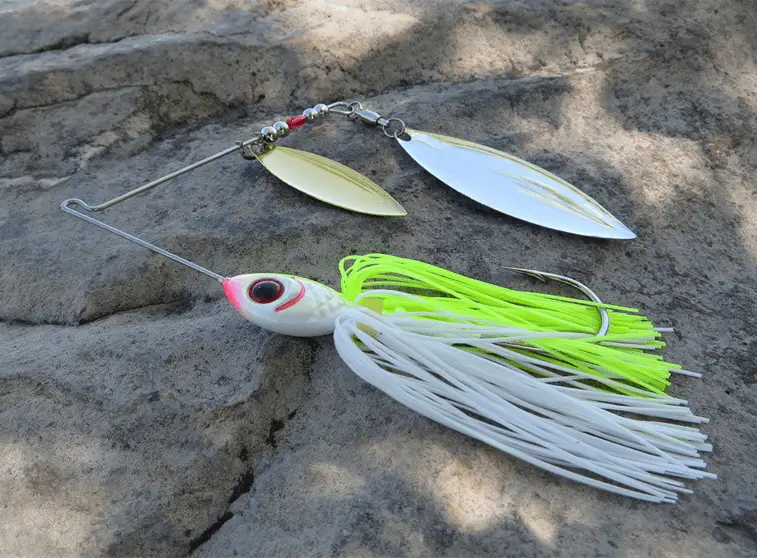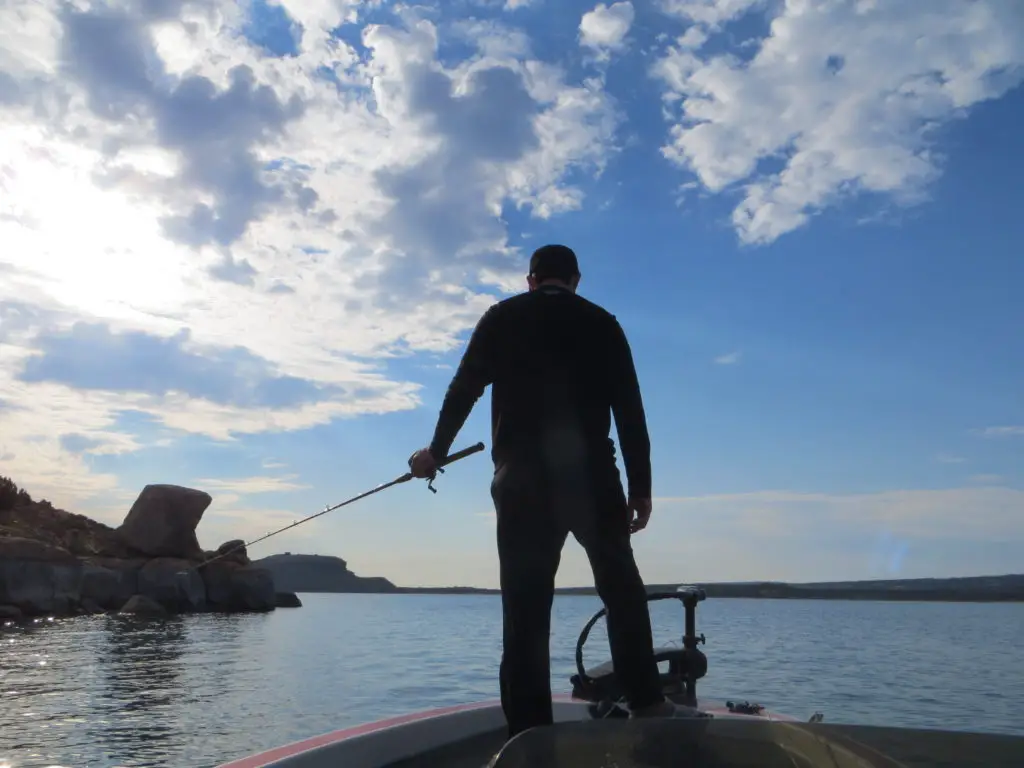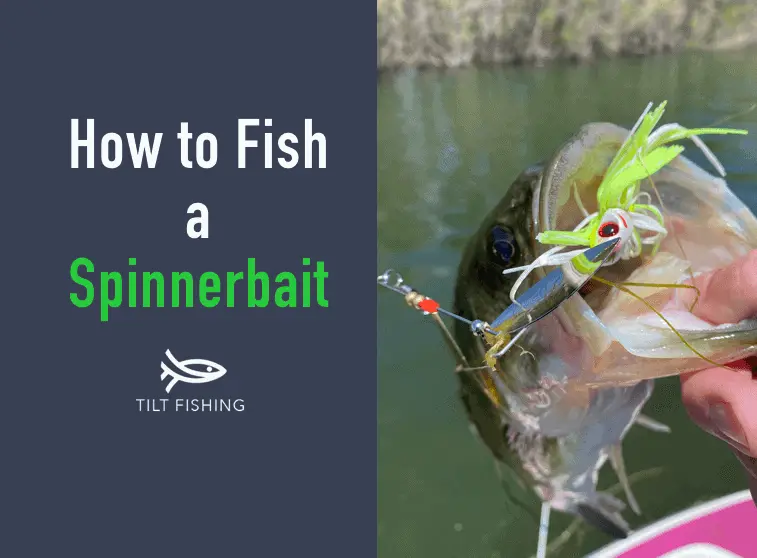Having an extremely versatile bait that you can fish in and around vegetation, bounce off wood to cover water and locate fish is an extremely important tool to have in your tackle box.
And that’s why spinnerbaits are a must have lure all year long. So you might be wondering what is a spinnerbait and how do you fish with one.
A Spinnerbait is a versatile fishing lure that has two main components: a lead head molded to a stout hook with an added skirt on one end and one or two blades on the other. These two ends are connected by a stainless steel wire that has a slot where you can tie your fishing line to. As a spinnerbait is retrieved its blades are designed to spin attracting fish with flash and vibration. The spinnerbait is also a weed-less bait making it popular among anglers targeting bass and musky around vegetation.
In this spinnerbait fishing guide, I’ll share you with more in-depth details on the different types of spinnerbaits, where to use them, how and when to fish a spinnerbait and some tips and tricks that will help you catch more fish using this versatile lure.
What’s a Spinnerbait?

A spinnerbait is by far one of the most versatile and effective fishing lures ever made. You can use this lure year round, throw it in and around cover, fish it up shallow or deep and catch fish with it in pretty much any condition.
The spinnerbait consists of a metal wire shaft, a jig head paired with a stout hook and 1-3 spinning metal blades. When retrieved through the water, the blades spin, flash as it catches sunlight and generates vibration by displacing water. This combination draws the attention of any nearby fish.
When it comes to the design of a spinnerbait, they come in several different blade combinations, wire lengths & sizes and a variety of heads. Each having a different action, sound, color, flash and vibration.
The main difference between the styles of spinnerbaits are the blades. Here is a look at the different types of blades and why they are used.
Willow Blade
Excels at generating flash, imitating baitfish and can be worked faster and more aggressively than other bladed spinnerbaits.
Willow blades are longer and narrower than other spinnerbait blades. They have a fish like shape and typically have less of cup than a Colorado blade. They come in gold, silver or painted colors.
Willow blades excel at generating flash and have less vibration when compared to other blades. They also move through the water easier allowing anglers to fish it at a much faster speed.
Colorado Blade
Generates a lot of vibration, slower rotation, ideal for fishing in stained and murky water at slow speeds and has a lot of drawing power.
Colorado blades are wider and shorter than willow blades, because of this they have a deeper cup that allows the blade to displace more water and give off more vibration. The Colorado blades also come in gold, silver or painted colors.
Because the Colorado blade excels at displacing water and creating vibration it’s a perfect tool to use in low visibility situation where the water is stained or muddy. However, it’s not designed to be fished fast, its more suited for a slower retrieve.
Indiana Blade
Has a moderate speed rotation and excels in moderate water conditions, has a raindrop shape and is a good in between blade from the slow Colorado and the fast willow leaf blades.
The Indiana blade looks similar to the Colorado blade but has more of a raindrop shape to it. The Indiana blade is essentially a combination of the Willow Leaf and the Colorado blade.
It produces more vibration than the Willow Leaf, but can also be fished at faster retrieval speeds than the Colorado blade. This combination when added to a spinnerbait gives it versatility and a happy medium between the two other blades.
For more in-depth information about all of the spinnerbait blades check out this article.
Different Types of Spinnerbaits
These days there are a ton of different spinnerbait styles and blade combinations and colors. In my experience there are only three main types that you need to worry about.
Here are the three most popular and effect spinnerbait combinations:
- Single or Double Colorado (Causes most vibration, best for muddy water)
- Double Willow (Best for clear water at faster speeds)
- Tandem Willow/Colorado or Indiana (Versatile and great overall)
These three spinnerbait blade combinations will keep you covered and are all you’ll need to fish during any conditions, at any body of water and all over the country.
Make sure to check out My Recommended Bass Fishing Gear and Tackle Guide to ensure you have the right gear for your next fishing adventure.
Best Spinnerbaits
There are literally hundreds of spinnerbaits on the market these days but if I could only own one spinnerbait to fish any lake, anywhere in the country I would choose the Strike King Tour Grade (Double Willow)
However, there are also a lot of great spinnerbait options that come in a variety of blade combinations, colors and sound. Here is a list of some of my favorite spinnerbaits organized by water clarity.
Best Clear Water Spinnerbaits
- Revenage Deep Runner
- Ware Eagle Screamin Eagle
- Strike King KVD Finesse Spinnerbait
- Strike King Tour Grade Double Willow Spinnerbaits
Best Murky Water Spinnerbaits
- River2Sea Bling
- Revenage Deep Runner
- War Eagle Gold
- Revenge Double Colorado
Now that we have gone over what a spinnerbait is and what are the best ones to use, let’s talk about the setup you’ll need and how to fish a spinnerbait.
Best Spinnerbait Setup
When fishing with a spinnerbait its extremely important that you have the right equipment. With the spinnerbait being a tool used for fishing around vegetation and through cover you are going to want to have heavier equipment. Heavy line, a strong rod and fast reel will help you pull bass out of the cover and into your net.
Here is the basic tackle and gear you’ll need to be able to fish a spinnerbait effectively:
- Line: 12-18 Monofilament or Fluorocarbon
- Rod: 7’4” Medium Heavy Fast
- Reel: Medium Speed Gear Ratio
- Soft Plastic Trailer
- Stinger Hook
Spinnerbait Trailers
A common question I hear many anglers ask that are new to fishing with a spinnerbait is: do you need to add a spinnerbait trailer?
A spinnerbait without a trailer is often more than enough to trigger a bass into striking. However, there are certain situations when adding a trailer will enhance your overall presentation and increase your chances of catching more fish.
If you want to catch more fish on a spinnerbait try using one of these trailers: 5 Killer Spinnerbaits Trailers.
How to Fish a Spinnerbait
The spinnerbait is one of the most reliable and effective lures for catching bass anywhere they are found. But you may be wondering how do you properly fish a spinnerbait.
If you aren’t familiar with fishing a spinnerbait it can be pretty simple, but there are a few things you can do that will dramatically increase your odds at catching bigger and more bass.
I’ve put together a simple step by step spinnerbait guide to help get you started.
How to Fish a Spinnerbait: 8 Easy Steps

Step1: Choose a Spinnerbait
Selecting the right spinnerbait for your style of fishing is a critical first step. In my opinion the most versatile and effective spinnerbait it the Strike King Tour Grade (Double Willow) ½ ounce. However, it’s best to choose your spinnerbaits by the water clarity and fishing conditions.
Here is a quick guide on what I use in different situations:
Double Willow Leaf Spinnerbait – My favorite over all, best used in clear water and can be worked the fastest
Colorado Spinnerbait (Single or double blade) – Ideal when fishing in muddy water, excellent drawing power with a lot of water displacement. Great option at night as well.
Tandem Willow/Colorado or Indiana – A great option when I like to mix things up and give the bass a different sound. I’ll mostly use these in stained and muddy water.
As far as colors go, my favorite color is white & chartreuse spinnerbait. In general, I use bright bolder colors in muddy water and more silver natural looking colors in clear water.
Step 2: Use the Proper Gear
Having the right tools and gear for the task at hand can make a big difference. Make sure you are using the right rod/reel, line and spinnerbait. Here is my recommend spinnerbait setup:
- Line: 12-18 Monofilament or Fluorocarbon
- Rod: 7’4” Medium Heavy Fast
- Reel: Medium Speed Gear Ratio
- Soft Plastic Trailer or Stinger Hook
Step 3: Tie a Strong Knot
The next step you’ll want to make sure you do, is to tie a strong knot. Having a solid knot could be the difference in breaking off or landing a big fish. Don’t let your knot be the reason a fish gets off. If you are using fluorocarbon the Palamor knot is hard to beat.
Step 4: Add a Spinnerbait Trailer & Hook
A great way to increase your catch rate is to add a trailer hook to your existing spinnerbait hook or by adding a soft plastic trailer. The extra hook will allow you catch more fish, especially when you get short strikes. The soft plastic trailer will add some bulk to your profile and give the bass an area to target.
Step 5: Target Key Areas
A spinnerbait like any bass fishing lure is a tool that excels in certain situations. The spinnerbait is the most effective on windy cloudy days or when there is low light conditions. It’s also perfect for covering water and fishing in and around vegetation.
Here are my favorite places to throw a spinnerbait:
- Grass
- Weed lines
- Points
- Docks
- Humps
- Riprap
Step 6: Make the Right Casts
One of the key aspects of fishing a spinnerbait is making the right type of casts in the right areas. You want to make sure your spinnerbait is in the “strike zone” for the most amount of time.
Meaning if the bass are up shallow cast parallel to the bank to allow you lure to be where the fish are at more of your cast. If the bass are hiding in vegetation cast right to where they are at. This will dramatically increase your odds at catching fish.
Step 7: Set the Hook
When you do detect a bite by feeling a jerk, vibration or something feels different make sure to set the hook. The best type of hook set for a spinnerbait is a sweeping hook set. When you feel the bite, quickly sweep the rod to your side and pull it back. This will give you the best odds of hooking the fish in the right place and ultimately landing your catch.
Step 8: Land the Fish
After you get a good hook set, its time to land your prized catch. As you are reeling in your fish, it’s important that you ensure your line is always tight. If not, the fish will be able to easily spit your spinnerbait.
Don’t rush reeling it in, especially if it’s a bigger fish. Keep your line tight and use a steady retrieve. If the fish does decide to jump, put your rod tip down to prevent the fish from getting off.
For additional spinnerbaits tips go check out this article by Bassresource.com
Spinnerbait FAQ
When should you use a spinnerbait? You can fish with a spinnerbait year round in pretty much any condition. However, the spinnerbait it best used in windy conditions, stained water and in low light conditions.
How fast should I reel in a spinnerbait? You can catch fish on a spinnerbait with a straight steady retrieval, but it’s the most effective if you mix up the speeds. One cast try fishing it fast while mixing in a few jerk or pops. If you haven’t caught anything after trying that for a bit mix it up and go slower.
Do you put bait on a spinnerbait? Live bait isn’t typically used when fishing with a traditional spinnerbait. Some anglers do add soft plastic trailers to the hook of their spinnerbait to give it added action and a target for the fish to shoot for.
Final Thoughts
A spinnerbait is a versatile lure that has an incredible amount of drawing power. It’s a great way to cover water, fish around and in vegetation and works year round. It’s especially effective for targeting bass and musky in murky and stained water.
It’s versatility, vibration and flash is what truly makes the spinnerbait a must lure that every angler should have in their tackle box.

